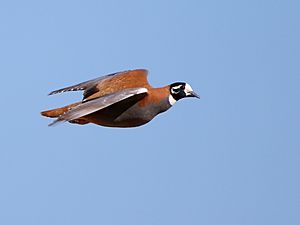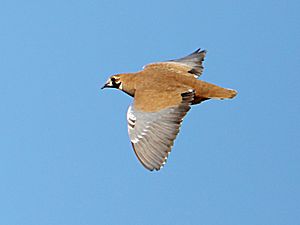Flock bronzewing facts for kids
Quick facts for kids Flock bronzewing |
|
|---|---|
 |
|
| Male | |
 |
|
| Female | |
| Conservation status | |
| Scientific classification | |
| Genus: |
Phaps
|
| Species: |
histrionica
|
The flock bronzewing (Phaps histrionica) is a type of pigeon. It belongs to the Columbidae family, which includes all pigeons and doves. This bird is special because it lives only in the drier parts of Australia. People sometimes call it the flock pigeon or harlequin pigeon.
Contents
Discovering the Flock Bronzewing
A British bird expert named John Gould was the first to describe the flock bronzewing. He wrote about it in his book The Birds of Australia. When he first saw this bird in 1839, he called it the harlequin bronzewing. He found it near the Mooki River in New South Wales, Australia.
What Does the Flock Bronzewing Look Like?
The flock bronzewing is known for moving around a lot, more than other Australian pigeons. It's also quite easy to tell apart from other birds. These pigeons can grow to be about 28 to 30.5 centimeters (11 to 12 inches) long. Their wings can spread out about 19 to 21.5 centimeters (7.5 to 8.5 inches) wide. They usually weigh between 260 and 320 grams (about 9 to 11 ounces).
Male Flock Bronzewing
Male flock bronzewings have a mostly black head. But they have a white forehead and a white patch on their lower throat. There's also a white line that goes from behind their eye, almost making a broken ring around their ear. Their upper body and wings are a reddish-sandy brown color. The main wing feathers are grey with some chestnut color inside. Most of these feathers also have white tips. Their eyes are dark brown, and their beak is black.
Female Flock Bronzewing
Female flock bronzewings look a bit different from the males. Their head, including the top and front, is sandy-brown. The black and white markings on their face and throat are much lighter than the male's. They also have a sandy-brown area across the front of their neck. Unlike the males, their main wing feathers do not have white tips.
Young Flock Bronzewings
Young flock bronzewings, called juveniles, look most like the adult females. However, their face markings are either missing or not as clear. Some of their wing feathers have brown tips. Their beak is a horn color, which is a yellowish-brown.
What Do Flock Bronzewings Eat?
Flock bronzewings mainly eat seeds from grasses, herbs, and small bushes. Sometimes, they also nibble on green plant shoots. Since cattle were brought to Australia, these pigeons have learned to eat undigested seeds found in cow dung. Some of the seeds they eat come from plants like desert spurge, camel bush, yellow daisy, and river grass.
Where Do Flock Bronzewings Live?
These pigeons are very good at living in the dry, flat areas of Australia. They prefer open grasslands with clumps of grass and small shrubs, and lots of open spaces. A big area where many flock bronzewings live is the grass plains of the Barkly Tableland.
Reproduction and Life Cycle
The time when flock bronzewings breed can change. It mostly depends on how much food is available. In the southern parts of their range, they usually breed from spring to early summer. In the northern areas, they breed from the beginning to the middle of the dry season.
Their nest is a simple scrape on the ground. They line it with grass and small twigs. They usually make their nest under the protection of grass clumps or shrubs. The female lays two white eggs. The eggs hatch after about 16 days. The young birds can leave the nest just one week after hatching!
Where Are Flock Bronzewings Found?
Flock bronzewings are most common in the Barkly Tablelands. This area is in the eastern Northern Territory and western Queensland. But they can be found in a much larger area. Sometimes, they appear in the Kimberly region of Western Australia, northern South Australia, and northwestern New South Wales. They are no longer found in the Liverpool Plains in New South Wales, where they were first discovered.
Threats to Flock Bronzewings
One of the biggest impacts on flock bronzewings has been from farming, especially raising cattle and sheep. In the mid-to-late 1800s, people wrote about huge flocks of these pigeons. But now, they are only seen occasionally in places like northern South Australia and western New South Wales.
Farming has affected both the number of birds and where they live. Farm animals eat the grasses that flock bronzewings need for food and for building their nests. Another danger to these birds is predators. Because they lay their eggs on the ground, their eggs and young birds can be easily found and eaten by other animals.
Images for kids
See also
 In Spanish: Paloma bronce arlequín para niños
In Spanish: Paloma bronce arlequín para niños



